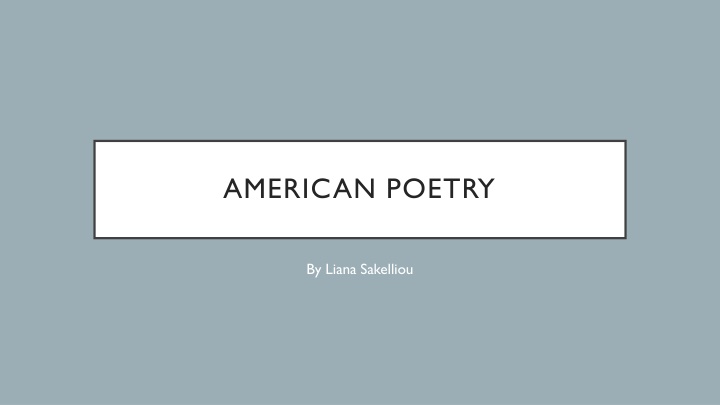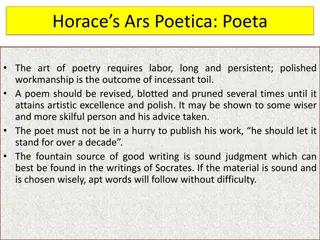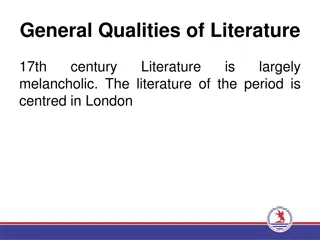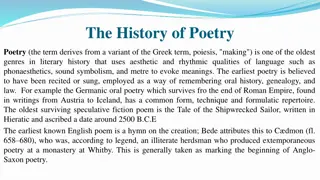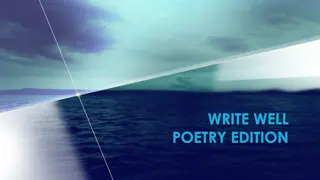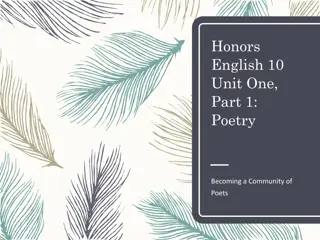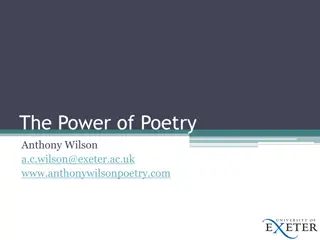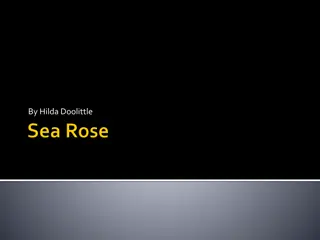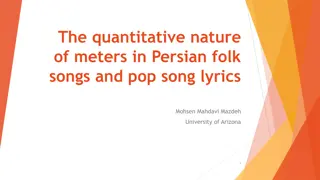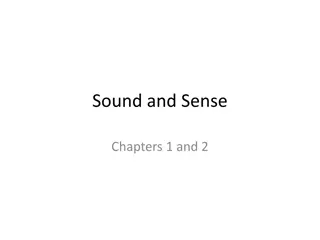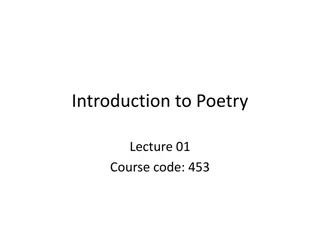American Poetry and Authors: A Brief Overview
Explore the works and impact of renowned American poets and authors including Jonathan Edwards, Ernest Hemingway, and Ralph Waldo Emerson. From the fervent sermons of Edwards to the poignant reflections of Hemingway and the philosophical musings of Emerson, these literary giants shaped American literature with their unique voices and perspectives.
Download Presentation

Please find below an Image/Link to download the presentation.
The content on the website is provided AS IS for your information and personal use only. It may not be sold, licensed, or shared on other websites without obtaining consent from the author.If you encounter any issues during the download, it is possible that the publisher has removed the file from their server.
You are allowed to download the files provided on this website for personal or commercial use, subject to the condition that they are used lawfully. All files are the property of their respective owners.
The content on the website is provided AS IS for your information and personal use only. It may not be sold, licensed, or shared on other websites without obtaining consent from the author.
E N D
Presentation Transcript
AMERICAN POETRY By Liana Sakelliou
JONATHAN EDWARDS (1703-1758) Edwards's sermons had enormous impact, sending whole congregations into hysterical fits of weeping. In the long run, though, their grotesque harshness alienated people from the Calvinism that Edwards defended. Edwards's dogmatic, medieval sermons no longer fit the experiences of relatively peaceful, prosperous 18th-century colonists. He is best known for his frightening, powerful sermon, "Sinners in the Hands of an Angry God" (1741): If God should let you go, you would immediately sink, and sinfully descend, and plunge into the bottomless gulf....The God that holds you over the pit of hell, much as one holds a spider or some loathsome insect over the fire, abhors you, and is dreadfully provoked....he looks upon you as worthy of nothing else but to be cast into the bottomless gulf.
ERNEST HEMINGWAY (1899- 1961) In A Farewell to Arms (1929), a novel about the tragic love affair of an American soldier and an English nurse during the war Hemingway writes: Once in camp I put a log on a fire and it was full of ants. As it commenced to burn, the ants swarmed out and went first toward the center where the fire was; then turned back and ran toward the end. When there were enough on the end they fell off into the fire. Some got out; their bodies burnt and flattened, and went off not knowing where they were going. But most of them went toward the fire and then back toward the end and swarmed on the cool end and finally fell off into the fire. I remember thinking at the time that it was the end of the world and a splendid chance to be a messiah and lift the log off the fire and throw it out where the ants could get off onto the ground. But I did not do anything but throw a tin cup of water on the log, so that I would have the cup empty to put whiskey in before I added water to it. I think the cup of water on the burning log only steamed the ants.
RALPH WALDO EMERSON (1803-1882) Ralph Waldo Emerson had a religious sense of mission. "To be a good minister, it was necessary to leave the church." The address he delivered in 1838 at his alma mater, the Harvard Divinity School, made him unwelcome at Harvard for 30 years. In it, Emerson accused the church of acting "as if God were dead" and of emphasizing dogma while stifling the spirit. In his essay "Self-Reliance," Emerson remarks: "A foolish consistency is the hobgoblin of little minds." Yet he is remarkably consistent in his call for the birth of American individualism inspired by nature. Most of his major ideas -- the need for a new national vision, the use of personal experience, the notion of the cosmic Over-Soul, and the doctrine of compensation -- are suggested in his first publication, Nature (1836).
RALPH WALDO EMERSON (1803-1882) Emerson loved the style of the 16th-century French essayist Montaigne, and he wanted to write a book like Montaigne's, "full of fun, poetry, business, divinity, philosophy, anecdotes, smut." He wrote Nature and Other Essays. This essay opens: Our age is retrospective. It builds the sepulchres of the fathers. It writes biographies, histories, criticism. The foregoing generations beheld God and nature face to face; we, through their eyes. Why should not we also enjoy an original relation to the universe? Why should not we have a poetry of insight and not of tradition, and a religion by revelation to us, and not the history of theirs. Embosomed for a season in nature, whose floods of life stream around and through us, and invite us by the powers they supply, to action proportioned to nature, why should we grope among the dry bones of the past...? The sun shines today also. There is more wool and flax in the fields. There are new lands, new men, new thoughts. Let us demand our own works and laws and worship.
WALT WHITMAN (1819-1892) Born on Long Island, New York, Walt Whitman was a part-time carpenter and man of the people. Whitman was self-taught; he left school at the age of 11 to go to work, missing the sort of traditional education that made most American authors respectful imitators of the English. His Leaves of Grass (1855), which he rewrote and revised throughout his life, contains "Song of Myself," the most stunningly original poem ever written by an American. The enthusiastic praise that Emerson offered Whitman in his poetic vocation, although the book was not a popular success, was to be included in a publication. Leaves of Grass was inspired by Emerson's writings, especially his essay "The Poet," which predicted a universal kind of poet like Whitman himself. The poem's innovative, unrhymed, free-verse form, open celebration of sexuality, vibrant democratic sensibility, and extreme Romantic assertion that the poet's self was one with the poem, the universe, and the reader permanently altered the course of American poetry. Leaves of Grass is as vast, energetic, and natural as the American continent.
EMILY DICKINSON (1830-1886) Emily Dickinson: A radical individualist, she was born and spent her life in Amherst, Massachusetts, a small Calvinist village. She never married, and she led an unconventional life full of inner intensity. She loved nature--the birds, animals, plants, and changing seasons of the New England countryside. Dickinson spent the latter part of her life as a recluse, possibly to make time for writing (she wrote about one poem a day). Her day also included homemaking for her attorney father, a prominent figure in Amherst who became a member of Congress. Dickinson knew the Bible, the works of William Shakespeare, and works of classical mythology. Dickinson was the most solitary literary figure of her time. Shy, withdrawn, unpublished and unknown, created the greatest American poetry of the 19th century. She has fascinated the public since the 1950s, when her poetry was rediscovered. https://www.emilydickinsonmuseum.org/bedroom360exhibit
EMILY DICKINSON (1830-1886) I Went to Heaven I went to heaven, - 'Twas a small town, Lit with a ruby, Lathed with down. Stiller than the fields At the full dew, Beautiful as pictures No man drew. People like the moth, Of mechlin, frames, Duties of gossamer, And eider names. Almost contented I could be 'Mong such unique Society. Cover from E.Dickinson's collected page of herbarium.Retrieved from http://www.slate.com/ blogs/the_vault/2013/ 06/04/emily_dickinson _her_collection_of_bot anical_speci ments.html
EDGAR ALLAN POE (1809-1849) Known for his gothic tales and psychological dramas, his stories include The Cask of Amontillado, The Fall of the House of Usher, and The Tell-Tale Heart. In 1845 he published The Raven and Other Poems. In The Philosophy of Composition, Poe turned his attention to poetry. The essay is a methodical account of how he came to write The Raven. He describes the deliberate choices he made in composing the poem, and the choices reveal his aesthetic. He advises brevity to communicate the essential effect of a piece. Beauty is the province of his work, and melancholy . . . the most legitimate of all the poetical tones. Poe discusses theme, setting, sound, and the merits of refrain. And, in the composition of The Raven in particular, he describes how he arrived at the figure of a raven instead of a parrot. Lenore was the name of the narrator's dead wife in "The Raven." She died of tuberculosis in 1847. The poem was published in 1845.
EDGAR ALLAN POE (1809-1849) Prophet! said I, thing of evil! prophet still if bird or devil! By that Heaven that bends above us by that God we both adore, Tell this soul with sorrow laden, if, within the distant Aidenn, It shall clasp a sainted maiden whom the angels name Lenore Clasp a rare and radiant maiden whom the angels name Lenore. Quoth the Raven Nevermore.
